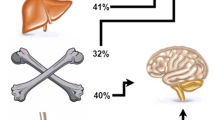Abstract
Background
Extensive-stage small cell lung cancer (ESCLC) includes metastatic disease and locally advanced disease confined to the thorax that cannot be encompassed in a typical radiation portal. We assessed and then compared the benefits of thoracic radiotherapy (TRT) and/or brain radiotherapy (BRT) on overall survival (OS) between the intrathoracic (T-ESCLC) and metastatic (M-ESCLC) groups using the Surveillance Epidemiology and End Results database.
Methods
TRT and BRT data were available for 10150 patients treated from 1988−1997. The T-ESCLC group included 1774 patients. The Kaplan–Meier method was used to estimate OS and the proportional hazards model was used to estimate OS hazard ratios for prognostic factors including age, gender, race, tumor size, T/N stage, TRT, and BRT.
Results
The 2-year OS for T-ESCLC was 7.8 % compared to 3 % in the M-ESCLC group (p < 0.001). In the T-ESCLC group, TRT and BRT were delivered to 750 and 102 patients, respectively. The 2-year OS was 13 % in the TRT group compared to 4.1 % in the no-TRT group (p ≤ 0.001) and 22.5 % in the BRT group compared to 7 % in the no-BRT group (p < 0.001). In the M-ESCLC group, TRT and BRT were delivered to 3093 and 1887 patients, respectively. The 2-year OS was 4.4 % in the TRT group compared to 2.8 % in the no-TRT group (p < 0.001) and 4.3 % in the BRT compared to 2.6 % in the no-BRT group (p < 0.001). Age, gender, TRT and BRT were significant OS prognostic factors in both groups.
Conclusions
Our study suggests that T-ESCLC is a disease entity distinct from M-ESCLC. Prospective studies to determine whether TRT should be recommended for the thoracic-only subgroup are warranted.



Similar content being viewed by others
References
Govindan R, Page N, Morgensztern D, Read W, Tierney R, Vlahiotis A et al (2006) Changing epidemiology of small-cell lung cancer in the United States over the last 30 years: analysis of the surveillance, epidemiologic, and end results database. J Clin Oncol 24(28):4539–4544
Oze I, Hotta K, Kiura K et al (2009) Twenty-seven years of phase III trials for patients with extensive disease small-cell lung cancer: disappointing results. PLoS One 4:e7835
Kalemkerian GP (2014) Advances in pharmacotherapy of small cell lung cancer. Expert Opin Pharmacother 15:2385–2396
Riess JW, Lara PN Jr (2014) Left behind? Drug discovery in extensive-stage small-cell lung cancer. Clin Lung Cancer 15:93–95
Slotman BJ, Senan S (2011) Radiotherapy in small-cell lung cancer: lessons learned and future directions. Int J Radiat Oncol Biol Phys 79:998–1003
Zelen M (1973) Keynote address on biostatistics and data retrieval. Cancer Chemother Rep 34:31–42
Shepherd FA, Crowley J, Van Houtte P et al (2007) The International Association for the Study of Lung Cancer Lung Cancer staging project: proposals regarding the clinical staging of small cell lung cancer in the forthcoming (seventh) edition of the tumor, node, metastasis classification for lung cancer. J Thorac Oncol 2:1067–1077
Kirchheiner K, Nout RA, Czajka-Pepl A et al (2015) Health related quality of life and patient reported symptoms before and during definitive radio(chemo)therapy using image-guided adaptive brachytherapy for locally advanced cervical cancer and early recovery––a mono-institutional prospective study. Gynecol Oncol 136:415–423
Jeremic B, Shibamoto Y, Nikolic N et al (1999) Role of radiation therapy in the combined-modality treatment of patients with extensive disease small-cell lung cancer: a randomized study. J Clin Oncol 17:2092–2099
Slotman BJ, van Tinteren H, Praag JO, Knegjens JL, El Sharouni SY, Hatton M, et al (2015) Use of thoracic radiotherapy for extensive stage small-cell lung cancer: a phase 3 randomised controlled trial. Lancet 385(9962):36–42
Slotman B, Faivre-Finn C, Kramer G et al (2007) Prophylactic cranial irradiation in extensive small-cell lung cancer. N Engl J Med 357:664–672
Edge SB, Compton CC (2010) The American Joint Committee on Cancer: the 7th edition of the AJCC cancer staging manual and the future of TNM. Ann Surg Oncol 17:1471–1474
Fisher RA (1922) On the interpretation of χ2 from contingency tables, and the calculation of P. J R Stat Soc 85:87–94
Kaplan EL, Meier P (1958) Nonparametric estimation from incomplete observations. J Am Stat Assoc 53:457–481
Fine JP, Gray RJ (1999) A proportional hazards model for the subdistribution of a competing risk. J Am Stat Assoc 94:496–509
Sundstrom S, Bremnes RM, Kaasa S et al (2002) Cisplatin and etoposide regimen is superior to cyclophosphamide, epirubicin, and vincristine regimen in small-cell lung cancer: results from a randomized phase III trial with 5 years’ follow-up. J Clin Oncol 20:4665–4672
National Comprehensive Cancer Network (2016) NCCN clinical practice guidelines in oncology: small cell lung cancer v1.2016. Available at: https://www.Nccn.Org/professionals/physician_gls/pdf/sclc.Pdf. Accessed 28 April 2016
Stahel RA, Ginsberg R, Havemann K et al (1989) Staging and prognostic factors in small cell lung cancer: a consensus report. Lung cancer 5:119–126
Nicholson AG, Chansky K, Crowley J et al (2016) The International Association for the Study of Lung Cancer Lung Cancer staging project: proposals for the revision of the clinical and pathologic staging of small cell lung cancer in the forthcoming eighth edition of the TNM classification for lung cancer. J Thorac Oncol 11:300–311
Author information
Authors and Affiliations
Corresponding author
Ethics declarations
Conflict of interest
The authors declare that they have no competing interests.
OM carried out the conception and the design of the study, assembly of the data, data analysis, interpretation, manuscript writing and final approval.
DK participated in data analysis, interpretation, and manuscript writing.
BG participated in data analysis, and manuscript writing.
JW participated in manuscript writing and final approval.
MS participated in conception and the design of the study, manuscript writing and final approval.
About this article
Cite this article
Mahmoud, O., Kwon, D., Greenfield, B. et al. Intrathoracic extensive-stage small cell lung cancer: assessment of the benefit of thoracic and brain radiotherapy using the SEER database. Int J Clin Oncol 21, 1062–1070 (2016). https://doi.org/10.1007/s10147-016-1011-z
Received:
Accepted:
Published:
Issue Date:
DOI: https://doi.org/10.1007/s10147-016-1011-z




